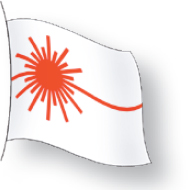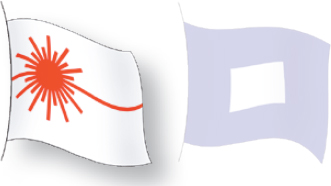
Class warning flags from 1879 racing rules. The flags ‘B’, ‘C’, ‘D’ and ‘F’ are from the 1857 Commercial Code (see page 30) denoting races 1,2,3 and 4. Classes and time allowances were determined by Thames Tonnage.
The popularity of signal flags as merchandise and marketing tools perhaps owes something to the continued use of International Code Flags in the management of yacht and dinghy racing. Sailing is not a spectator sport and the starting process may seem arcane, but while athletes crouch on their blocks awaiting the starter’s gun, the start of a yacht race is not quite so straightforward, as anyone who has made the long sail out to the start line, often among dozens of other boats of different classes, will know.

Class warning flags from 1879 racing rules. The flags ‘B’, ‘C’, ‘D’ and ‘F’ are from the 1857 Commercial Code (see page 30) denoting races 1,2,3 and 4. Classes and time allowances were determined by Thames Tonnage.

Aide-memoire for racing flags and their meanings.

Start -5 minutes. Gun.

Start -4 minutes. Gun.

Start -1 minute. Gun.

Start. Gun.

Warning signal, class flag displayed.

Preparatory signal, ‘Blue Peter’ with class flag. Additional flags ‘I’ and ‘Z’ may warn of penalty rules in effect.

‘Blue Peter’ lowered leaving class flag only.

Class flag lowered (to dip if boats over the line until all have returned to re-start). Next sequence starts.

Laser Training Centre, Cabarete
Close sailing at start of 2009 Laser World Championships, Halifax Nova Scotia.
Ever since the rules governing what were called sailing matches were agreed under the auspices of the Yacht Racing Association in 1875, the format has been broadly the same – a warning signal, a preparatory signal and a start signal. What has changed over time is the intervals between these three and the addition of several flags to indicate events such as postponement, a recall or that particular rules and penalties will be applied. Many of the original rules will be familiar to competitors today – though perhaps not Rule 14 ‘There shall be no limit as to the number of paid hands… [but] no paid hands may join or leave a yacht after the signal to start’!1 With large fully-crewed yachts lining up in tidal waters, many starts were made from moored buoys, with sails only fully set once the start gun had gone and a warning period of thirty minutes. The alternative, a running start, we are more familiar with today, with a start line at right angles to the course to the first mark, usually directly up-wind. The flags and present day timings are shown here.